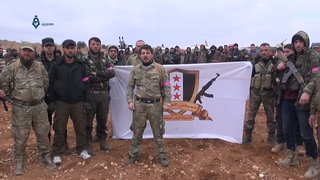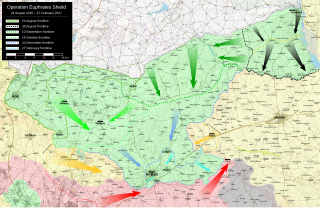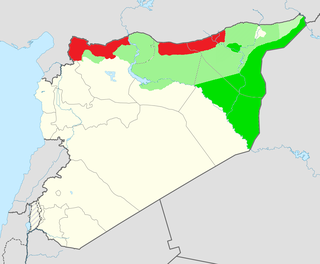Related Research Articles
This is a broad timeline of the course of major events of the Syrian civil war. It only includes major territorial changes and attacks and does not include every event.

Turkey's involvement in the Syrian civil war began diplomatically and later escalated militarily. Initially, Turkey condemned the Syrian government at the outbreak of civil unrest in Syria during the spring of 2011; the Turkish government's involvement gradually evolved into military assistance for the Free Syrian Army in July 2011, border clashes in 2012, and direct military interventions in 2016–17, in 2018, in 2019, 2020, and in 2022. The military operations have resulted in the Turkish occupation of northern Syria since August 2016.

AANES–Ba'athist Syria relations concern the military and political relations between the Ba'athist Syrian Arab Republic and the Autonomous Administration of North and East Syria (AANES), a de facto autonomous multi-ethnic region in northern and eastern Syria. The Syrian Ba'athist government did not officially recognise the autonomy of the AANES, and advocated a centralist approach to the governance of Syria. The NES seeks the federalisation of Syria. For most of the Syrian civil war, there was a non-aggression pact between the military of Syria and the Syrian Democratic Forces, with occasional confrontations and some cooperation against Islamist groups, in particular against the Turkish Armed Forces and the Turkish-backed Syrian National Army. While the two sides co-operated militarily under Russian supervision since 2019, with Syrian and Russian troops stationed along the Turkish border to prevent further advances, political negotiations ended in failure. The Assad regime had no authority or institutions in North and East Syria outside of its two security boxes in Qamishli/Qamislo and Al-Hasakah/Heseke. The Autonomous Administration did not allow the Syrian Government to hold elections in areas under its control.

The Manbij offensive, code-named Operation Martyr and Commander Faysal Abu Layla, was a 2016 military offensive operation by the Syrian Democratic Forces (SDF) to capture the city of Manbij from Islamic State of Iraq and the Levant (ISIL), and eventually, the ISIL-held areas through Al-Bab to Herbel, in the area referred to as the "Manbij Pocket" in the northern Aleppo Governorate. The main goal of the offensive was to cut off ISIL's last supply routes from Turkey, and to prevent ISIL fighters from escaping across the Syria–Turkey border. For the first five days of the offensive, the US-led coalition conducted over 55 airstrikes in support of the SDF. After capturing Manbij city on 12 August, the SDF announced that the offensive would continue until the whole countryside around Manbij was captured, though the offensive effectively ended shortly after the Turkey, who regard the YPG elements in the SDF as a terrorist organisation, initiated Operation Euphrates Shield to prevent the SDF uniting the regions of Rojava.
Arima, also spelled Orayma or Arimah, is a town and seat of a subdistrict (nahiya) in Al-Bab District, located 20 kilometers (12 mi) northeast of the city of al-Bab and 65 kilometers (40 mi) northeast of Aleppo in northern Syria. In the 2004 census, it had a population of 2,839. The town of Qabasin is also to the south-west, and closer than Al-Bab. Manbij city is to the north-east. In course of the Syrian Civil War, the town repeatedly changed hands. As of 2020, it was under dual control of the Syrian government and the Autonomous Administration of North and East Syria (AANES).

Operation Euphrates Shield was an offensive by the Turkish Armed Forces and the Turkish-backed Free Syrian Army, which led to the Turkish occupation of northern Syria. Operations were carried out in the region between the Euphrates river to the east and the rebel-held area around Azaz to the west. The Turkish military and Turkey-aligned Syrian rebel groups, some of which used the Free Syrian Army label, fought against the forces of the Islamic State (IS) as well as against the Syrian Democratic Forces (SDF) from 24 August 2016. On 29 March 2017, the Turkish military officially announced that Operation Euphrates Shield was "successfully completed".
The following is a timeline of the Syrian Civil War from January to April 2017. Information about aggregated casualty counts is found at Casualties of the Syrian Civil War.

The East Aleppo offensive (2017), also referred to as the Dayr Hafir offensive, was an operation launched by the Syrian Army to prevent Turkish-backed rebel forces from advancing deeper into Syria, and also to ultimately capture the ISIL stronghold of Dayr Hafir. Another aim of the operation was to gain control of the water source for Aleppo city, at the Khafsa Water Treatment Plant, in addition to capturing the Jirah Military Airbase. At the same time, the Turkish-backed rebel groups turned towards the east and started launching attacks against the Syrian Democratic Forces, west of Manbij.
The Manbij Revolutionaries Battalion, also simply known as Manbij Revolutionaries, is a Syrian militia that is part of the Syrian Democratic Forces' Manbij Military Council and operates in the Aleppo Governorate. Members of the unit have declared that their primary goal is to drive the Islamic State of Iraq and the Levant (ISIL) from Syria, and to establish a democratic, inclusionist government in the country.
The following is a timeline of the Syrian Civil War from May to August 2017. Information about aggregated casualty counts is found at Casualties of the Syrian Civil War.

The Northern Democratic Brigade is a Free Syrian Army unit that is closely allied to the Syrian Kurdish YPG and YPJ in Afrin Region since 2014. Led by Absi Taha, Alexander Khalil, and Alexander Alaa, it also joined the Syrian Democratic Forces (SDF) in November 2015. The initial members of the group originated from Jabal Zawiya in Idlib, and it has recruited Arabs from Idlib, Aleppo, and other cities in northern Syria since allying with the YPG. Since joining the SDF, the unit has begun to operate across much of northern and eastern Syria, participating in operations against anti-SDF Syrian opposition factions, the Islamic State of Iraq and the Levant, the Turkish Armed Forces, and the Syrian National Army.
The following is a timeline of the Syrian Civil War from September to December 2017. Information about aggregated casualty counts is found at Casualties of the Syrian Civil War.
The following is a timeline of the Syrian Civil War from January to April 2018. Information about aggregated casualty counts is found at Casualties of the Syrian Civil War.
The following is a timeline of the Syrian Civil War from September to December 2018. Information about aggregated casualty counts is found at Casualties of the Syrian Civil War.

The Eastern Syria insurgency is an armed insurgency being waged by remnants of the Islamic State of Iraq and the Levant (ISIL) and both pro and anti-Syrian government Arab nationalist insurgents, against the Autonomous Administration of North and East Syria (AANES), its military, and their allies in the US-led Combined Joint Task Force – Operation Inherent Resolve (CJTF–OIR) coalition.
The following is a timeline of the Syrian civil war for 2020. Information about aggregated casualty counts is found at Casualties of the Syrian civil war.
The following is a timeline of the Syrian civil war for 2021. Information about aggregated casualty counts is found at Casualties of the Syrian civil war.
The following is a timeline of the Syrian civil war for 2022. Information about aggregated casualty counts is found in Casualties of the Syrian civil war.
The following is a timeline of the Syrian civil war for 2023. Information about aggregated casualty counts is found in Casualties of the Syrian civil war.
The following is a timeline of the Syrian civil war from November 2024. Information about aggregated casualty counts is found in casualties of the Syrian civil war.
References
- ↑ "Exchanged and continuous attacks between the National Front and Hayyaat Tahrir al-Sham in the countryside of Idlib and Hama, and more casualties raise to about 100, the number of casualties in 3 consecutive days of bloody fighting". SOHR. 3 January 2019.
- ↑ "International Coalition warplanes carry out the first massacres of 2019 and kill 11 civilians including 8 children and women, and continuous clashes and shelling in the ISIS-controlled enclave". 3 January 2019. Retrieved 3 February 2019.
- ↑ "Trump Adviser: US to Leave Syria Once IS Beaten, Kurds Safe". New York Times . 6 January 2019. Retrieved 7 January 2019.
- ↑ Desk, News (8 January 2019). "Russian military begins armored patrols around Manbij (video)". Archived from the original on 4 April 2019. Retrieved 3 February 2019.
{{cite web}}:|last=has generic name (help) - ↑ "US-led coalition says Syria withdrawal has begun". Arab News. 11 January 2019. Retrieved 19 February 2019.
- ↑ HASSAN, MOHAMMED (13 January 2019). "#Manbej #Syria A joint military base between the Russian military police, the Syrian army and the forces of the Manbej military council in the town of Al-Arima, 18 km west of Manbejpic.twitter.com/SZ7z0oczqk" . Retrieved 3 February 2019.
- ↑ "U.S. confirms American troops killed in blast claimed by Islamic State in Syria". The Washington Post. January 16, 2019. Retrieved January 16, 2019.
- ↑ Barić, Joško (2019-01-15). "Syrian War Daily – 15th of January 2019". Syrian War Daily. Archived from the original on 2019-04-16. Retrieved 2019-01-16.
- ↑ "French military to continue fight against Daesh in Levant: Macron". Arab News. 17 January 2019. Retrieved 3 February 2019.
- ↑ News Desk (2019-01-18). "Breaking: Massive explosion rocks Idlib city, 15+ killed". AMN - Al-Masdar News | المصدر نيوز. Archived from the original on 2019-04-17. Retrieved 2019-01-18.
- ↑ "Israel bombs Iranian targets in Syria". Arab News. 21 January 2019. Retrieved 3 February 2019.
- ↑ "Israel will block 'Iranian aggression' after Syria strikes". Arab News. 21 January 2019. Retrieved 3 February 2019.
- ↑ "Bomb explodes on southern edge of Damascus". Syrian Organization of Human Rights. 20 January 2019. Retrieved 2023-03-23.
- ↑ "'Huge' Blast Hits Damascus Near Security Facility". Radio Freee Europe-Radio Liberty. Retrieved 2023-03-23.
- ↑ "Bomb Explodes on Southern Edge of Damascus; Separate Bombing Kills Three in Afrin". Haaretz. Retrieved 2023-03-23.
- ↑ "Suicide attack on Kurdish-US convoy in Syria kills 5: monitor". Arab News. 21 January 2019. Retrieved 3 February 2019.
- ↑ "Islamic State Faces Possible Territorial Elimination". Syrian Civil War Map - Live Middle East Map/ Map of the Syrian Civil War. 2019-01-20. Archived from the original on 2019-04-19. Retrieved 2019-01-22.
- ↑ "Clashes reported from inside Al-Baghuz Fawqani". liveuamap/ Map of the Syrian Civil War. 2019-01-20. Retrieved 2019-01-23.
- ↑ "US coalition forces overrun last ISIS village in Syria". The National. 23 January 2019. Retrieved 2019-01-23.
- ↑ "U.S. sanctions hit Iran-backed airlines, fighters in Syria - Middle East - Jerusalem Post". www.jpost.com. Retrieved 3 February 2019.
- ↑ "Putin Says Turkey and Russia Ready to 'Stabilize' Syria's Idlib - 'Liquidate' Terrorists". Haaretz. Reuters and DPA. 24 January 2019. Retrieved 3 February 2019.
- ↑ "France 'to repatriate 130 suspected Isil members from Syria' over security concerns". 29 January 2019.
- ↑ "US court finds Assad regime liable for Marie Colvin's death in Syria". 31 January 2019.
- ↑ Building collapses in Syria’s Aleppo killing 11
- ↑ "U.S.-backed Syrian forces reject ISIS request for safe passage to Turkey". Ahval. Archived from the original on 2019-05-08. Retrieved 2019-02-02.
- ↑ "Rukban camp in Syria receives first aid in three months". www.aljazeera.com. Retrieved 19 February 2019.
- ↑ qsd1. "عاجل: قوات سوريا الديمقراطية تطلق معركتها الأخيرة – قوات سوريا الديمقراطية – Syrian Democratic Forces" . Retrieved 19 February 2019.
{{cite web}}: CS1 maint: numeric names: authors list (link) - ↑ "Armenia sends mine-clearing experts, doctors to Syria". 9 February 2019.
- ↑ "Russia, Turkey agree on decisive action in Syria's Idlib: RIA". Reuters. 11 February 2019. Retrieved 19 February 2019– via www.reuters.com.
- ↑ "Syria stuck with Assad for now, says UK minister Jeremy Hunt". Arab News. 16 February 2019. Retrieved 19 February 2019.
- ↑ "War monitor: Regime shelling kills 18 civilians in northwest Syria". The National. 17 February 2019. Retrieved 19 February 2019.
- ↑ "At least 24 killed, 25 injured in twin explosions in Syria's Idlib". DailySabah. 18 February 2019. Retrieved 2019-02-18.
- ↑ 20 February 2019. The Washington Post. "Allies decline request to stay in Syria after U.S. troops withdraw"
- ↑ "About 200 U.S. peacekeepers are to remain in Syria". CBS News. 21 February 2019.
- ↑ Erdogan says safe zone on Syria border must be under Turkey's control. Reuters. 23 February 2019
- ↑ "Assad meets Khamenei in first Iran visit since Syrian war began". Reuters. 25 February 2019.
- ↑ Sang, Lucia Suarez (2019-02-28). "Mass grave with dozens of decapitated bodies found in last ISIS enclave: 'They were slaughtered'". Fox News. Retrieved 2019-02-28.
- ↑ "Syria war: Lawyers submit first war crimes cases against Assad". BBC. 7 March 2019.
- ↑ "Syrian forces and Russian jets intensify attacks on last rebel bastion". 13 March 2019.
- ↑ Tomlinson, Lucas (2019-03-19). "ISIS fighters tied to killing 4 Americans in Syria captured by US-backed forces, US official says". Fox News. Retrieved 2019-03-19.
- ↑ Jansen, Michael. "Kurds report 'significant progress' in fight against Isis in Baghouz". The Irish Times. Retrieved 2019-03-20.
- ↑ "Syrian fighters search tunnels as seige [sic] on the last Islamic State outpost comes to an end - The Boston Globe". BostonGlobe.com. Retrieved 2019-03-21.
- ↑ Jeremy Diamond and Jennifer Hansler (21 March 2019). "Trump says it's time for US to recognize 'Israel's Sovereignty over the Golan Heights'". CNN. Retrieved 2019-03-22.
- ↑ "′Islamic State′ defeated in Syria: US-backed Syrian forces". DW. Retrieved 2019-03-23.
- ↑ "Trump formally recognises Israeli sovereignty over Golan Heights". www.aljazeera.com. Retrieved 2019-03-25.
- ↑ "Syrian military: Israeli air attack targeted Aleppo". www.aljazeera.com. Retrieved 2019-03-28.
- ↑ McKay, Hollie (2019-04-01). "Despite crumbled caliphate, hunt for Baghdadi continues in Syria". Fox News. Retrieved 2019-04-02.
- ↑ "At least 15 reported killed as Syrian government, rebels exchange fire". Reuters. 7 April 2019.
- ↑ "Syria: 2 children killed, 5 injured in Aleppo's landmine blast". 13 April 2019. Retrieved 13 April 2019.
- ↑ "Syria says Israeli airstrike on military position wounds 6". The Washington Post . 13 April 2019. Archived from the original on 13 April 2019.
- ↑ "Jihadist Kills Almost 50 Regime Fighters Across Syria". VOA. 20 April 2019.
- ↑ "Syria war: Kosovo brings back 110 citizens including jihadists". BBC. 20 April 2019.
- ↑ "Arabs in Syria's Deir al-Zor protest against ruling Kurdish..." Reuters. 28 April 2019. Retrieved 16 May 2019– via www.Reuters.com.
- ↑ Neilan, Catherine (2020-04-07). "UN says 'highly probable' that Syrian regime and allies behind bombing of hospitals in Idlib". The Telegraph. Retrieved 2021-03-24.
- ↑ Islamic State leader al-Baghdadi appears in new video